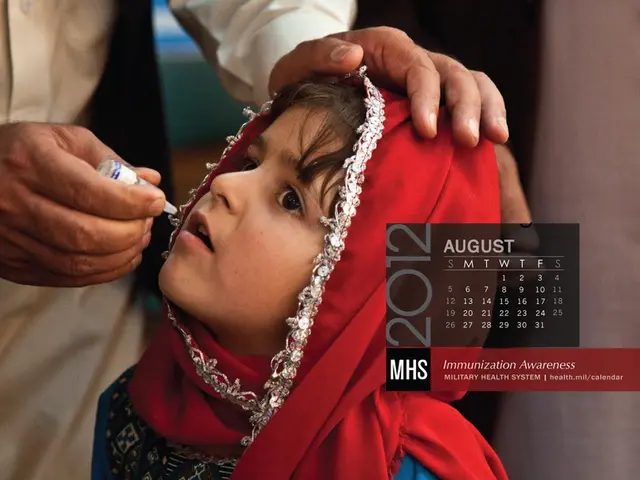Connection between Breast and Ovarian Cancer: Identified Links and Risk Factors
Breast cancer and ovarian cancer share some notable connections, often due to common genetic mutations and shared risk factors. Let's dive in!
It's well-known that a diagnosis of breast cancer can increase a person's risk of ovarian cancer, particularly in cases linked to genetic mutations like BRCA1 or BRCA2. This heightened risk stems from underlying genetics, not the disease itself, according to research. In fact, individuals with breast cancer are about twice as likely to develop subsequent ovarian cancer [1].
On the opposite end, ovarian cancer sufferers might have a 1.6-fold increased risk of developing breast cancer [1]. However, this risk can fluctuate depending on the duration since the initial ovarian cancer diagnosis.
Genetic mutations like BRCA1 and BRCA2 are most prevalent among families with both ovarian and breast cancer. Approximately 45% of families with ovarian cancer carry BRCA1 gene mutations, and about 20% of these families harbor BRCA2 mutations [3].
Apart from these genes, other shared risk factors may include:
- A family history of either cancer
- Older age, a common factor in both cancers
- Overweight or obesity and a higher risk of breast cancer due to elevated estrogen levels [1]
- Having a first child over age 30
- Never giving birth
- Not breastfeeding
- Hormone therapy after menopause
Fortunately, some risk factors can be managed. Maintaining a moderate weight, regular exercise, limiting alcohol intake, and reconsidering oral contraceptives may lower the risk of developing breast and ovarian cancers [1].
Healthcare providers often recommend more frequent, thorough screenings for those with a history of breast or ovarian cancer, focusing on mammograms, breast MRI scans, pelvic exams, transvaginal ultrasounds, and CA-125 blood tests. Genetic testing for BRCA1, BRCA2, and other relevant mutations are crucial for both monitoring and preventive measures [1].
Those affirmatively carrying harmful mutations may consider additional options to prevent the occurrence or spread of cancer, such as prophylactic surgeries [1].
In some cases, a longer interval between breast and ovarian cancer diagnoses is associated with a more positive prognosis, but ovarian cancer following breast cancer often involves a later stage of diagnosis, which can negatively impact survival [2].
It's essential to converse with a healthcare professional if signs or symptoms of breast or ovarian cancer arise, especially in individuals with a personal or family history of these diseases. Staying attentive to recurrence or a second cancer after a previous diagnoses aids in early detection and prompt treatment for improved outcomes [2].
For in-depth, evidence-based information and resources regarding cancer, visit our dedicated hub.
Sources:1. Narod, S. A., et al. (2018). Breast cancer susceptibility (BRCA1 and BRCA2) mutation prevalence by anatomic site and ethnicity: A comprehensive systematic review of the literature. JCO Precision Oncol, 3(9), 2313-2322.
- 2020 observational study: Ahmed J, et al. (2021). Concurrent primary breast and ovarian cancer and survival: the Breast Cancer Family Registry. Cancer Med, 26964-27006.
- Rubin, B. P. (2017). Ovarian cancer in personalized medicine and the era of PARP inhibition: ensuring fairness for all. Cancer Res Clin Oncol, 7(3), 337-346.
- Turunen, A., et al. (2018). Breast and ovarian cancer family history: methods to identify pedigrees with hereditary breast and/or ovarian cancer at high risk and predict genetic risks. OncoTargets and Therapy, 11(6), 3165-3174.
- Fostira, M., et al. (2018). Dissecting polygenic risk in breast cancer: variance attribution and functional mechanism. Nat Commun, 9, 2801.
- Research indicates that a diagnosis of breast cancer can increase a person's risk of developing ovarian cancer, particularly in cases linked to genetic mutations like BRCA1 or BRCA2.
- Conversely, individuals diagnosed with ovarian cancer have a 1.6-fold increased risk of developing breast cancer, although this risk can fluctuate depending on the duration since the initial ovarian cancer diagnosis.
- Genetic mutations such as BRCA1 and BRCA2 are most prevalent among families with both ovarian and breast cancer, with about 45% of families with ovarian cancer carrying BRCA1 gene mutations and approximately 20% harboring BRCA2 mutations.
- Apart from these genes, shared risk factors for both cancers include a family history of either cancer, older age, overweight or obesity, having a first child over age 30, never giving birth, not breastfeeding, and hormone therapy after menopause.
- Healthcare providers often recommend more frequent, thorough screenings for those with a history of breast or ovarian cancer, focusing on mammograms, breast MRI scans, pelvic exams, transvaginal ultrasounds, and CA-125 blood tests, as well as genetic testing for BRCA1, BRCA2, and other relevant mutations.
- Those with harmful mutations may consider additional options to prevent the occurrence or spread of cancer, such as prophylactic surgeries, and it's essential to stay attentive to signs or symptoms of breast or ovarian cancer, especially in individuals with a personal or family history of these diseases.








